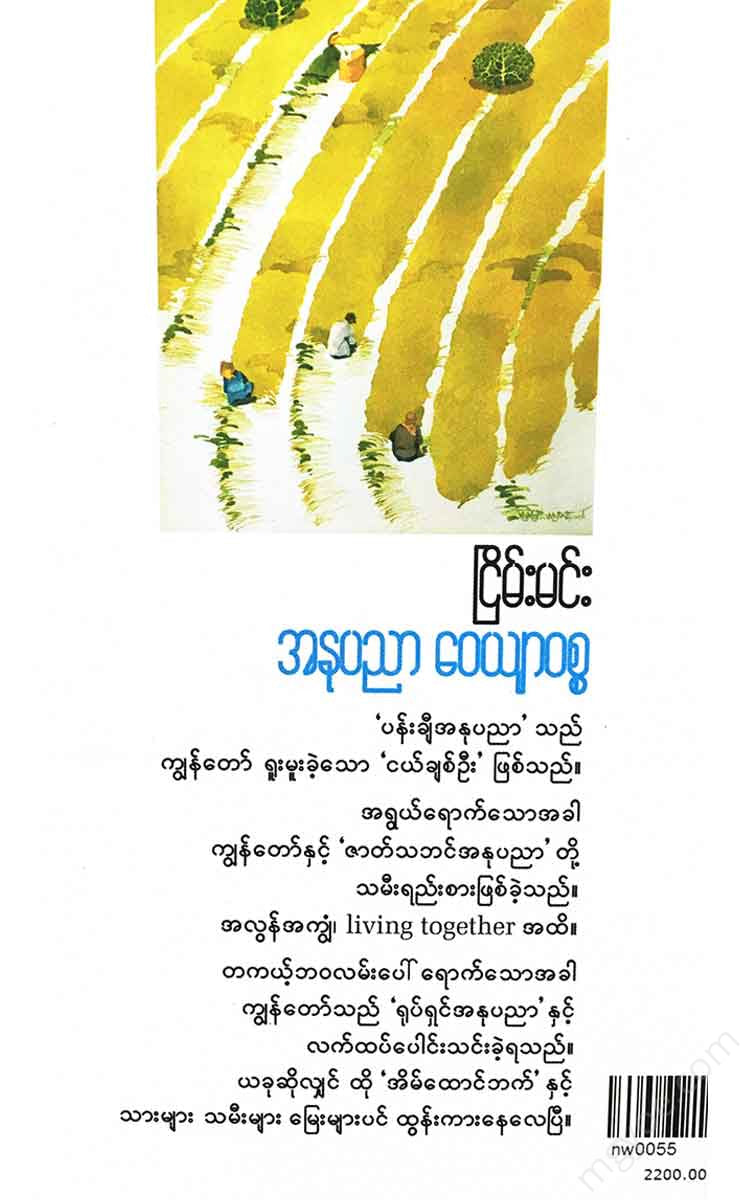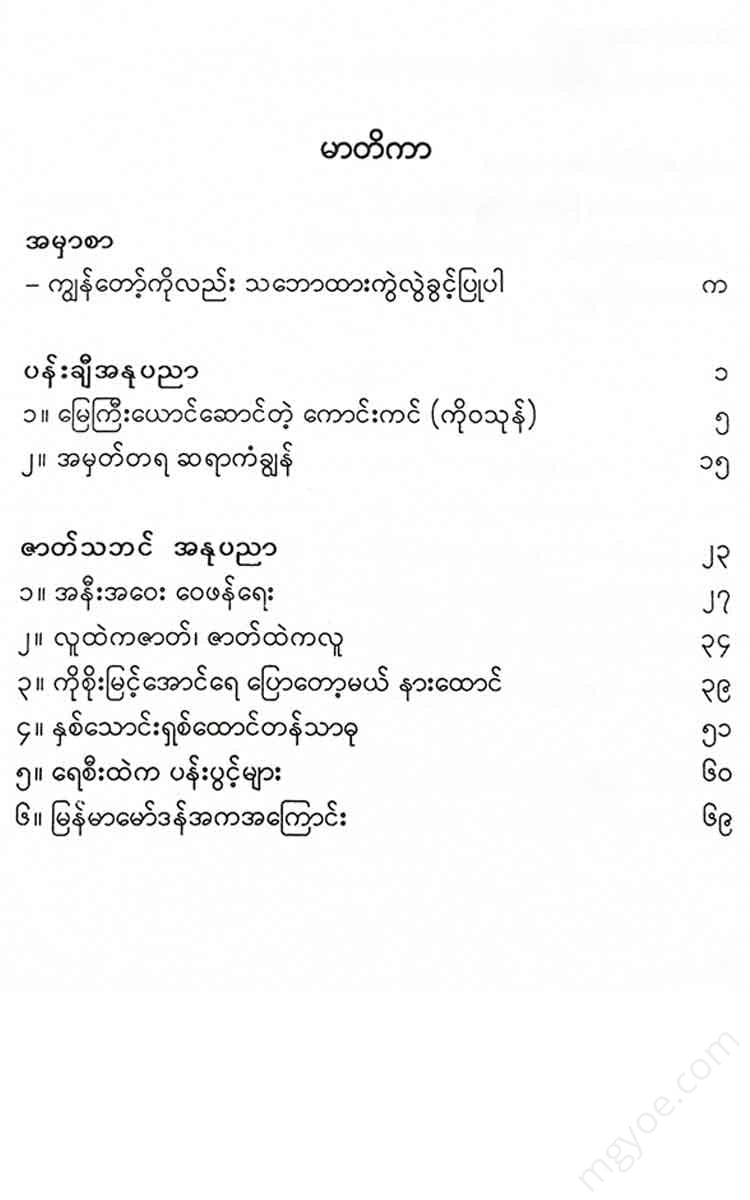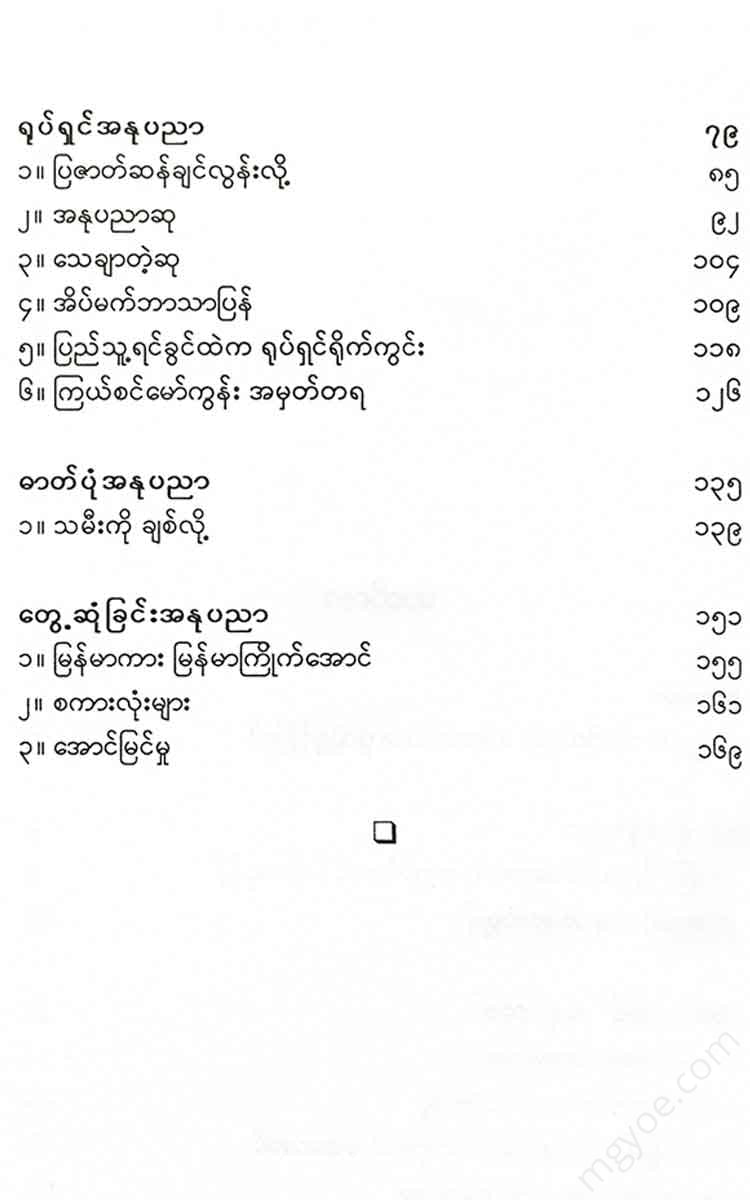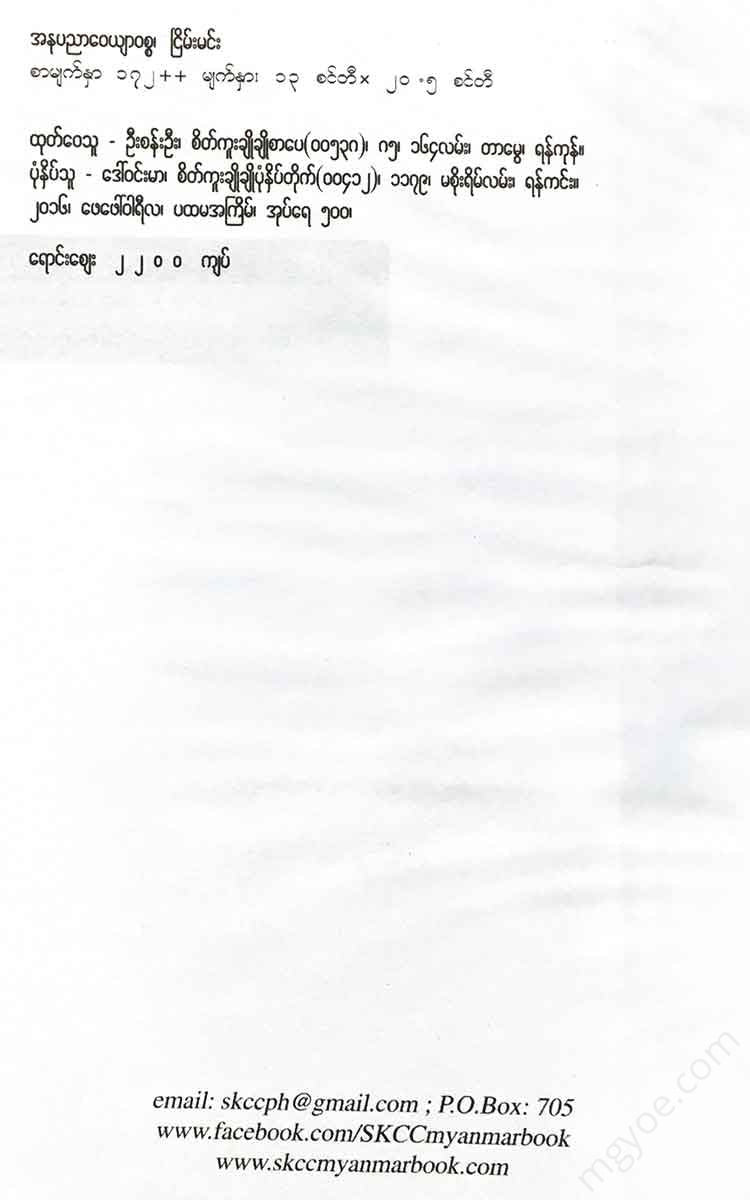စိတ်ကူးချိုချိုစာပေ
Nyein Min - Art and Culture
Nyein Min - Art and Culture
Couldn't load pickup availability
Veyavissa = Carrying out big and small matters ( Pali Dictionary of Vocabulary - U Tun Myint)
"Many matters, countless chores, day and night..."
(Nana Sangha Nap, Monk Kyul Sayadaw)
In the neighborhood... at the temple... at the monastery... at the pagoda square... you may have heard of the "Wayyawisa Association". When I was young, I formed a Wayyawisa Association to raise funds for the library. After assigning the Wayyawisa Association to host the entire wedding, the bride and groom would donate money and help each other. The young members of the association worked hard to ensure that all aspects of the wedding were taken care of.
There are many young people who want to and can do the job of serving cakes and ice cream in front of the guests, but few people want to do the job of cleaning up the leftover dishes of the guests. In fact, the work of the people who clean up behind the scenes is indispensable for the success of a large wedding.
That's right. The pages of my life, which I went through invisibly (before I even had a name), to earn a place in the art world and hear the audience's awe-inspiring words of praise and applause, are very bittersweet. This...
Some are "sufferable,"
Some are "zealous"
"Some are filled with virtues."
"Some are filling their stomachs."
Whatever you call it, it is the foundation for every artist. The most important foundation for a successful building is to build and strengthen it through the unseen hardships. If you sweat a lot while doing the hardships, you will definitely bleed a lot in your artistic life.
"There are heavy and tiring tasks and small and light things in the world. The important and the unimportant are often confused. Here, we must be careful that what we thought was unimportant in our youth is often surprisingly important when we are 'mature'. Therefore, it is best to be careful and diligent in every step we take.
Life is a never-ending school of lessons, isn't it? What's the point of lessons? Some lessons are so painful that I don't want to repeat them. I don't want to repeat them to the young. I don't want their fragile minds to be frightened and scattered.
2
What is a screenwriter...
I was so busy writing that I didn't have the chance to write a book. And I didn't get the chance to write the things I wanted to write. I only had to write the words that were part of the story. When I got the momentum of the journey, I started to remember and write about the things I didn't say, the things I failed to say, the things I didn't say.
When I was a playwright, screenwriter, and director.
I had to show the audience to come to my stage, to make the audience accept my art, to show the "views" of other people who were not me and my own "inner self". I appeared, disappeared, sank, and crossed over. I couldn't even notice whether the city I was in was turning east or west. I had to immerse myself in the stage.
I didn't write anything except the script for the play.
The car rolls I had to ride, the covered wagon I had to pull, the trolley I had to push, the handcart I had to hold, the
I can't think of anything that has to do with the microphone that I've been yelling at. I've given more than I can give to the audience. The drama is a complete syllabus, from "A" to "A". Given all this time, what kind of writing can I do?
Ko Soe Myint Aung (Aung Lan Film) and Ko Aye Kyu Lay (Pythu Film) came to ask me for interviews, and I remembered myself. They asked me if I had anything to say about drama. It would be more accurate if you said it. Even though I was someone who had the right to speak about drama, I didn't say anything worth saying, and I couldn't say it.
My basic character is that I have a strong desire to do as much as I can without saying what should be said. This may be my weakness. No matter how much I don't say it, people don't see the background of my drama. Many fans don't even know that I came from the drama.
Looking back on my life... I wrote about the drama that I experienced with tears in my eyes.
The article is in 5 parts. So I added the interview “About Modern Dance”. Among the interviews that I can no longer find, there is an interview that Ko Win Sithu, Ko Aung Thaik Gyi, me, and 3 theater artists were interviewed by Ko Myat Khaing, arranged by Ko Win Nyein, Ko Soe Myint Aung, and Ko Aye Kyu Lay. The fact that I couldn’t find that “interview” left a big void in my mind (if anyone can find it, please help me).
I dusted off all the articles I found and, as usual, asked the students to sort them into computers. This time, it was Myo Min Htwe, a young man who graduated from the University of Fine Arts and was writing scripts for MRTV 4. He was no stranger either. He was a director who had won a warm award at the Human Rights Film Festival. I also had these students to sort. He said he was educated. It was like having to go through an art project in practice (no)... He said as he sorted his articles into computers.
“Many of the articles are older than me.” That's when I realized the big generation gap.
“What do you get from reading these articles?” “Wow...there are so many, so many things I don't know anything about.” “Do you think they will be useful to you?”
“It’s an experience I didn’t have to go through myself, it’s very valuable. There’s a lot to take away, especially for young people who are going to be artists.”
“Are there still young people like you?” “Many, sir.”
3
A friend of mine said that the youth of this era don't have a taste for Burmese music. They don't smell the fragrance of Burmese culture. I immediately responded. That's only half the responsibility of the youth. The other half is the responsibility of the adults who don't tell them.
I just had to tell him that.
To answer the question of how much I have said about myself, I have collected my artistic works and made an effort to turn them into a book.
As life gets older...
The lessons I want to share with the young (the new generation with a true artistic spirit) are overflowing. When I have little to give and much to give, I realize that writing is the best way to express myself. But the hard part is time. Let it go.
Now, let's throw away the whining and complaining and collect and share the "artistic trivia". This book contains some artistic truths that have not changed despite changing times.
Actually, it's a collection of old ones.
Memories are stored.
It's like watching an old black and white movie again, and there will be some disappointments. There will be some denials. But I'm sure I'll have the opportunity to see and experience the reality and evolution of the Burmese art world.
As you read these letters, the reader and I are free to disagree.
4
The articles in this book were written between 1984 and 2010. They are not listed in chronological order, but rather in order to make them easier to read. I would like to thank the journals and magazines that published these articles. I would also like to express my gratitude to the editors who interviewed me to get the words out of my mouth.
I would like to express my special thanks to my dear student Myo Min Htwe, who completely re-typed the old articles, U Maung (President of the Myanmar Art Association, U Maung Maung Hla Myint) for allowing me to use the cover art, and Ikubo Cho Cho, who patiently illustrated my whims while understanding my whims.
Especially thank you..
"To the young people who read this book, it is impossible to feel differently if you are from a different generation."
Young people of today....
Listen to the voices of the youth of the past. Feel the emotions and fashions of the youth of that era.
Sometimes you can find unexpected ways, ways, answers, and exits in the old. You may find yourself looking for something in the most unexpected places. Because the “old” is the groundwork that gives birth to the “new.”
Try playing the melody I played on the piano on your guitar.
You'll definitely enjoy listening to a new and unique tune.
Well... from now on, allow me to disagree.
Peaceful
July 2014









